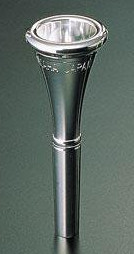Tuba to Horn
Scroll through this page to see the similarities and differences between tuba and horn to get you started on your new instrument.

Comparison Chart

Tuba
The Tuba mouthpiece is more C-cupped, wider and deeper with a thicker rim. It is the largest of the brass mouthpieces.
French Horn
The French Horn mouthpiece is more V-shaped and narrow with a thinner rim. It is the smallest of the brass mouthpieces.


Embouchure Comparisons
Tuba
To form a Tuba embouchure your lips will be more even than on the horn. Your buzz on tuba will be more relaxed and you will use more of your bottom lip. Free buzzing is not as suggested when working on your Tuba embouchure and buzz.


French Horn
For a French Horn embouchure, your upper lip will come over your lower lip a bit more and more of your upper lip will go into the mouthpiece. Your resting embouchure shape should look like a diamond.


Horn Angle & Mouthpiece Placement
Tuba
On the Tuba, the lead pipe and mouthpiece should be straight forward at your mouth for a student model or piston tuba. If playing a rotary or four valved tuba, there may be a slight downward angle of about 15 degrees. Your lips should be evenly centered inside the mouthpiece.


French Horn
The French Horn mouthpiece and lead pipe need to be angled down at about 35 degrees to direct the air properly into the instrument. You should have about 2/3 of the upper lip and 1/3 of the lower lip inside the mouthpiece. Anchor the mouthpiece on your bottom lip and rest it on your top lip. You want to avoid pressure on the top lip as much as possible.


Mouthpiece Comparisons
Clefs
If your first instrument was the tuba, then you are probably used to reading in bass clef. Switching to horn will mean you'll have to learn treble clef. Use the pictures below to compare your bass clef and treble clef notes.
Tuba

French Horn



